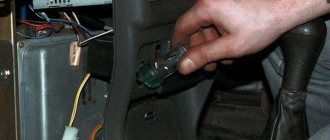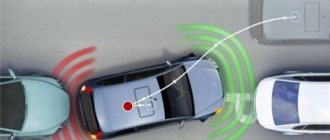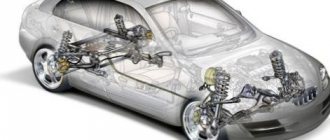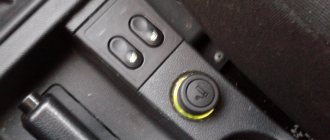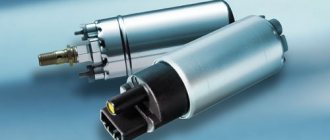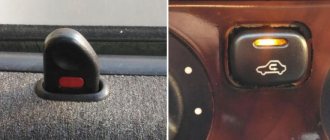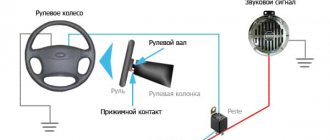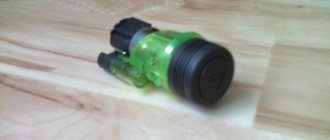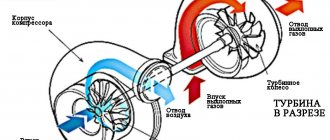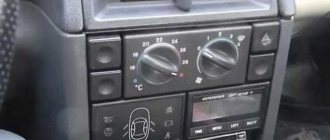Repair and replacement of parking sensors from A to Z
If recently parking sensors were considered a luxury, then in a big city where finding a parking space is quite difficult, it has become a necessity. If the parking sensors do not work, then for those who are used to using them, this is a real problem. The article discusses the main malfunctions of the device, ways to check the sensor, and provides instructions on how to disable, remove and replace the device on your car.
Repair and prevention
After we have found out why the parking sensors are not working and made a diagnosis, it is time for repair work. If you don’t have enough knowledge of car electrical systems, it’s better to contact a specialist auto repair shop. Replacement is carried out quickly, the driver receives a guarantee for all types of work.
Prevention of breakdowns is very important to maintain comfort and safety while operating the machine.
Preventative measures must be taken to ensure that the parking radar lasts a long time. The main recommendation would be to periodically wipe the sensors from dirt, water and dust. It is also necessary to prevent temperatures in the cabin from rising above those specified in the operating instructions. Metallized tape requires wiping surfaces from moisture. Installation must be carried out strictly according to the instructions. After installation, you need to check whether the sensitivity settings are set correctly. If all actions are performed correctly and timely diagnostics are carried out, the service life of the radar will be long, and the operation of the device will not cause interruptions or breakdowns.
Common malfunctions of parking sensors and its components: causes and symptoms
Parking sensors are a lifesaver if there is very little parking space. Its sensors provide warning signals to the driver if there is an obstacle in the form of a fence or another vehicle. The closer the obstacle, the stronger the signal.
Parking Radar Monitor
Motorists quickly learn to trust the device that signals danger. But if the parking sensors do not stop beeping, even if there is no obstacle, then parking is difficult and urgent repair of the device is required.
Before you figure out why the parking sensors don't work, you need to know how they work. It detects obstacles using sensors that send ultrasonic waves in different directions from the car. When the waves hit obstacles, they return as an echo, and the ECU and speaker warn the driver of the danger.
If the parking sensors are faulty, the most common reason is a malfunction of some sensor.
All faults can be divided into three groups:
- breakdown of sensors or their contamination;
- faulty ECU;
- wiring damage.
Methods for diagnosing a parking sensor
If parking sensors are installed from the factory, an indicator on the instrument panel will light up indicating a sensor malfunction. The question arises: how to check the parking sensors if there is no indicator. A sign of a broken parking sensor will be either a constant squeak or its absence when approaching an obstacle. To find out why the parking radar does not work, you need to diagnose its components.
Acoustic parking system
The device consists of:
- The control unit, thanks to which the entire acoustic parking system operates. It can be checked using an ohmmeter by touching the terminals of the device to the outputs. If the ECU is faulty, the tester will not show anything.
- Indication devices: screen and sound alarm. They do not break often, as they are located in the cabin and are rarely damaged.
- Sensors and metallized plates. Thanks to them, obstacles are discovered. They are installed on the front and rear bumpers. This allows you to control the space both behind the car and in front.
Sensors are most susceptible to damage, as they get hit by stones, dirt, water and snow (video author – STO Garazhok).
When SHOULD it fire?
Normally, the parking radar should turn on automatically when you engage reverse gear. If sensors are also installed on the front bumper, then the system is activated when the vehicle speed drops below 20 km/h.
But there is one caveat! The parking sensors should only beep when there are obstacles. If the parking or traffic zone is “clear”, the sensors should be silent.
Ultrasonic parking radars are more common in our country. They work like echo sounders. The locators emit short ultrasonic pulses, the latter are repelled by obstacles and return to the sensors. The control unit calculates the distance to the object based on the speed of sound in the air (which is always constant). The closer the car gets to the obstacle, the more desperately the gadget beeps. If you get closer than 15 cm, as a rule, the squeak turns into a continuous signal that cannot be ignored.
So why does the parking sensor beep constantly, immediately when you engage reverse gear, even if there are no obstacles in its range of action? What will be the answer to the logical question: what did the ultrasound push off from if there are no objects around?
Let's try to figure it out!
Features of parking sensor repair
If the parking sensors constantly beep, then the following reasons are possible:
- The sensors are dirty. In this case, they need to be inspected and cleaned.
- If cleaning doesn't help, there may be a wiring problem. In this case, you need to call the wiring and eliminate breaks if they are found.
- It happens that the device beeps in the cold. The reason for this is water that got inside the device and froze. The way out of this situation is to dry the sensors.
- The last reason why the parking device beeps continuously may be incorrectly configured sensitivity of the sensors. They incorrectly estimate the distance to the obstacle and therefore constantly squeak. The solution is simple - adjust the sensitivity correctly.
If the parking radar stops working, you should first understand which sensor does not respond to an obstacle. A faulty device should be replaced.
Rear parking sensors
If all sensors are working properly and the device does not beep, you should try increasing the sensitivity.
The most expensive and unpleasant malfunction is a breakdown of the ECU. A new control unit, like repairs, is an expensive proposition.
Instructions for dismantling and replacing the device
The need to replace the sensor arises if a stone gets into it. Even a small pebble can break the mirror of the device. In this case, it cannot be restored. There is only one way out - replacement with a working device.
Replacing a sensor at a car service center in most cases is very expensive, so it’s easier to buy a new device and repair the parking sensors yourself.
When choosing a sensor, it is important to select one that exactly fits in size and characteristics.
The replacement procedure is simple. Before removing the sensor, you need to disconnect the wires from it. After turning off the power, you can remove the old device. Then you need to take a new sensor, connect the wires and secure it to the inside of the bumper.
It is possible that the old and new device will differ in color. Their design allows for the application of small amounts of paint. Therefore, they can be painted in any suitable color. Before painting, the surface should be degreased so that the paint lasts longer.
Price issue
Why does not it work
The specifics of parking sensor malfunctions do not depend on the type and class of car where it is installed. Whether it is a passenger car or a heavy truck, there is no difference in breakdowns. There are the following reasons for system failure:
- Manufacturing defects. A low-quality parking sensor will begin to malfunction immediately after purchase, but may work for some time and then become unusable. If there is a warranty, you must take the damaged device to the store and demand monetary compensation or replacement of the device by a worker.
- Wiring faults. Often the parking sensors stop performing their functions if there are problems with the wires connecting the radars and the control unit. The metallized tape attached to the bumper also affects the efficiency of operation. If its fixation is not good enough, the sensor will become loose and the final result will be inaccurate. When installing the device yourself, you need to make sure that the connections and fastenings are secure.
- Failed power supply. This problem is rare, but it cannot be ruled out. Electronic units of modern parking sensors are capable of notifying the driver of failures. Therefore, in the event of a breakdown, a corresponding notification will appear indicating the need for repair.
- Penetration of water and dirt. Parking sensor malfunctions also occur when interacting with water or dirt, which can damage the sensors and metal strips located on the back of the bumper. Often the unit stops working due to a collision with a stone. Dust and dirt cause malfunctions not only of radars, but also of the electronic control unit. If they appear on the circuit, there is a risk of a short circuit.
After washing or in snowy weather
Many motorists often contact the service center with a complaint that the parking sensors turn off after washing or in snowy weather in winter. The reason is explained by moisture getting on the working elements of the system, as a result of which they stop working. You can fix this problem yourself.
Beeps when there is no obstacle
Often, parking radars begin to operate, making a corresponding sound, even if there is no obstacle. The reasons why sensors start beeping just like that are:
- Failures in the ECU.
- Damage to the wiring, causing the sensor to stop working properly or display data incorrectly.
- Mechanical damage to the sensor. The problem is eliminated by replacing the failed unit.
Basic parking sensor malfunctions
It doesn’t matter what kind of equipment the parking sensors are installed on, a car or a warehouse cart, the faults are, in principle, the same, except for minor insignificant damage related to the specifics of the car or cart.
- The first trouble that can happen to the device is a manufacturing defect. In this case, there is only one way to solve the problem - return the device to the manufacturer and get a new one.
- Parking sensor malfunctions most often occur in connecting wires, sensors or metallized tape, more precisely at the place where it is attached to the bumper of the vehicle.
- Much less often, a malfunction occurs in the parking sensor control unit. It must be said that the control unit is equipped with its own fault detection system. If it detects a malfunction, the driver is given a corresponding signal.
- Troubles related to water and dirt can happen to the parking sensors or tape. The sensor may also be damaged by stones caught in it. The parking sensor tape must be constantly cleaned of dirt and moisture. To do this you have to remove it and clean it, it’s worth cleaning the bumper at the same time. The sensor is not particularly afraid of moisture and water, but if it accumulates, moisture or water can damage it.
- The control unit most often fails if dirt, dust, or moisture gets on the printed circuit. A short circuit may occur. Block failures are rare. Determine the simplest, for example. short circuit, malfunction, you can do it yourself. The rest depends on the skill and knowledge of the parking sensor owner.
- Parking sensor wiring may become unusable if the wires are poorly secured. As a result, they may melt or break. You can call and replace the wiring or part of it yourself.
What to do
When buying parking sensors for your car, you need to make sure that it is in working order. The new part must respond to any obstacles placed in front or behind the machine. If there is no signal about an obstacle, it is better to refuse to purchase this model and look for another option.
If problems arise in the operation of the old device, you should clean its surface from dirt and dust that accumulates as the system is used. In frequent cases, such simple manipulations restore the functionality of parts.
When cleaning, it is important to pay special attention to the places where the sensors are attached. They must not be contaminated, otherwise the sensor will not be able to properly receive the signal and transmit it to the electronic unit. You should also inspect the reliability of fastening of the working elements.
How to identify a faulty sensor
It is not difficult to identify a faulty parking sensor. The check is carried out by touching the sensor while the power plant is idling. If there are no malfunctions, the sensor should vibrate slightly and make a cracking sound when in contact with a finger. If such signs are not noticed, then he was not taken out of action.
If you need to diagnose the control unit, you will need to contact a car repair shop. It is impossible to check such a complex system with your own hands. But it is possible to conclude that the inoperability of the parking sensors is related to the unit only after a thorough diagnosis of other parts of the device.
To check the parking radar for a short circuit, just use an ohmmeter and connect the ends of the probe to the terminals of the unit. If a short circuit occurs or there is a break, the instrument needle will remain at zero. To eliminate the defect, you need to contact a specialist.
But at home it is not difficult to diagnose a printed circuit board. To do this, remove the cover, under which dirt or dust may accumulate. Often there are traces of scale inside the block structure. In this case, you will need to replace the radio components, including the capacitor.
Repair
If the parking sensors are damaged, you can try to restore them yourself. The first solution is to dry out the radars. If the device malfunctions after rain, snow or a visit to the car wash, there may be liquid on it. In this case, the system will return to its previous operating mode immediately after drying. If this does not happen, you will need to dismantle and open the device to check the membrane for damage. A failed part needs to be replaced. But you shouldn’t do this on your own. It is better to entrust it to a car mechanic.
If the parking sensors do not work, but the sensors are cleaned of dirt and water, the metallized tape may be damaged. It is not difficult to identify the problem - any defect will be noticed visually.
If there is no signal from the strip parking sensors, diagnostics and repairs will be carried out according to the same principles as in the case of the sensor system.
The first step is to assess the external condition of the working units and get rid of contaminants.
Next you should check the reliability of the connection and fixation of the wires.
Fixing a malfunction in the rear or front parking sensors with your own hands is problematic. It is better to entrust such a task to a specialist from a service center or service station.
How to prevent breakdowns
In order not to encounter malfunctions in the operation of parking sensors, it is necessary to service them in a timely manner, protecting them from negative factors. First of all, you should protect the system from water and dirt, so after each ride in rainy or snowy weather, visiting a car wash and driving off-road, you need to clean the sensors. If minor problems occur in the form of infrequent false alarms, it is not necessary to contact the service center.
But if the problem is a complete failure or display of inaccurate results, you cannot do without the intervention of a professional technician.
Determining the cause of a parking radar failure and repairing it
Parking sensor malfunctions are often associated with the failure of one of its elements. An acoustic parking system consists of several important components.
- The control unit is its main part, which is responsible for the operation of the entire system.
Quite rarely, this particular element fails. How to check the functionality of the electronic control unit? You need to disconnect it first. Then you should attach the ohmmeter terminals to the terminals. If the ohmmeter does not show anything, then the cause of the malfunction lies precisely in the electronic control unit. If you are not an electrician and do not have sufficient experience working with such mechanisms, it is better not to repair parking sensors yourself. Here it is worth turning to specialists.
Incorrect settings of the control unit may also be one of the reasons why the parking radar does not work. If the control unit is configured to be more sensitive, the parking radar will respond even to non-existent obstacles. Or the opposite situation, he does not notice the existing obstacles. This may indicate that sensitivity is too low. In both cases, it is necessary to reconfigure the parking radar.
- Indication devices: monitor (data is transmitted to it regarding the presence of obstacles and the distance to them) and a sound warning system (it emits warning signals). These elements fail the least often, since they work in the most gentle conditions, inside the car.
- Sensors or metallized plates are transmitting devices that detect the presence of obstacles nearby. In a car there can be from 2, 4, 6 or even 8. The most often installed are 4 or 6. If 4, then they are all installed on the rear bumper. If 6 are installed, then 4 of them are on the rear, and 2 on the front bumper. The latter option allows you to control not only the space behind the car, but also in front. The operating principle of the transfer device is very simple. It emits ultrasonic signals, which return back when they hit an obstacle. The system reads the round-trip time of the signal, thus calculating the distance to the interference.
The parking sensor monitor fails less often than other elements, since it is located inside the car.
Sensors fail most often, because they are the ones most exposed to the external environment. They are installed on the bumper of the car, and accordingly they can get dirt, snow or water.
How to determine that the parking sensor is not working? Simple enough. You should start the car and touch the sensor with your finger. A working one always vibrates slightly, and if you touch it, it should make a cracking sound. If this was not found, then this is the reason.
But before you go to a car repair shop, you can try to repair the parking sensors yourself. The first thing to do is clean and dry it. If after these manipulations the system does not work, then perhaps the cause of the breakdown lies in the membrane. In order to identify a membrane malfunction, the sensor should be opened. If it is faulty, it must be replaced. However, it is not recommended to change the membrane yourself; it is better to entrust this to an auto mechanic.
But sometimes a different situation happens: a pebble hits the sensor, which disables it. In such cases, repairing the parking sensor is no longer possible; it only needs to be replaced.
If the machine has metallized plates, then complete failure and the need to replace them will be indicated by the presence of any external damage.
How to replace the sensor or plate? Simple enough. You should buy a device suitable in size and technical parameters from a spare parts store and install it in place of the broken ones. If the sensor is different in color from what it was, then fixing it is quite simple; it should be repainted.
Sometimes sensors start to fire for no reason, signaling the presence of non-existent obstacles - the cause of the malfunction may be due to contamination, sticking of sensors or metallized plates. If you have sensors, you should clean them of dirt and snow; if there is moisture, remove it. If plates are installed, it is better to remove them, because water and dirt can accumulate not only on the surface, but also under them. After this, the bumper must be washed and dried. Only then can you put the dry and clean plates back.
If the parking sensors do not work after washing or in severe frost, then the problem may lie in the wiring, or more precisely, in the connections that get wet. Regular drying of the sensors and wiring connections will also help here.
Why the parking sensors do not work: the main reasons and malfunctions
Hi all! Cars are becoming more and more intelligent and filled with various electronics. The parking assistance system is far from new. He's a parking attendant. Today we will touch on the topic of why the parking sensors do not work, what this may be connected with and how to determine the cause of the malfunction.
Parking radar allows you to reduce the risk for the driver of colliding with other cars, road users and simply different objects when the car is parked in a limited space or driving in reverse.
There are front and rear parking sensors. I think everyone knows what its operating principle is and how radars work. Special sensors are placed on the car that react to approaching objects. The notification comes in the form of a sound signal or graphics, which is displayed on the display inside the cabin. Moreover, the intensity of the signal increases as it approaches.
Design features and types
Regardless of whether you use standard or self-installed parking sensors, it may fail. Moreover, we will consider a situation where everything was fine, but suddenly the radar stopped working.
Electromagnetic and ultrasonic types of parking sensors are used on sale and as standard equipment for cars. They have slightly different principles of operation, since they are based on the use of different sensors. If we talk about Russia and the CIS countries, then ultrasonic systems are more in demand here. They are divided into wireless and wired. This issue should be dealt with separately if you plan to install a radar yourself or through a car service that was not provided from the factory.
The design of ultrasonic systems uses ultrasonic sensors and a control unit. In fact, the block is the brain of the equipment.
As for the electromagnetic analogue, that is, the role of the sensor is taken on by a metallized tape. It is fixed to the inside of the bumper. Using the tape, an electromagnetic field is generated. When an object or obstacle hits it, the sensor transmits a signal to the control unit, which informs the driver of the danger.
The advantage is on the side of the electromagnetic option. This is due to the fact that here, unlike its ultrasonic competitor, there is no such thing as blind or dead zones. Such tape-based systems provide better control over strictly defined distances and areas. That is, they are characterized by a more efficient and accurate reaction to what is happening in front and behind the car. But there is no limit to perfection. Increasingly, the car receives not only a standard radar, but also an additional camera. This allows you to combine graphics, sound signals and video images.
Objectively, the benefits of rear parking sensors are much greater than those of the front ones. But the latter also greatly helps the driver to maneuver in certain situations.
Possible causes of malfunctions
Taking into account everything discussed earlier, we can say that parking sensors are inherently a fairly simple device. It consists of a minimum set of components. Hence the corresponding number of malfunctions.
Their appearance does not depend on the car itself. Someone was lucky to receive the radar as a complete set. Others customize their cars themselves. Parking sensors are often found on a wide variety of cars. Especially on things like:
- Lada Priora;
- Toyota Rav 4;
- Kia Sorento;
- Lada Largus;
- Hyundai ix35;
- Lada Vesta;
- Volkswagen Passat;
- UAZ Patriot;
- Chevrolet Captiva;
- Chevrolet Cruze;
- Kia Sportage 3;
- Skoda Octavia;
- Mercedes;
- Hyundai Solaris, etc.
The list could go on forever. But something else is much more important here.
There are several main reasons why the parking sensors suddenly stopped working, or began to display incorrect information, or send alerts prematurely or late.
If you notice problems with your car, then the reason probably lies in one of the following factors.
- Damage to wiring. Systems can be wired or wireless. When using wiring, it is not so difficult to damage and compress it;
- Incorrect installation of sensors. Here it is important to understand how to find out which sensor is not working. Check their fastening and degree of immobility. If the element wobbles and does not hold well, this is the reason;
- Manufacturing defects. This cannot be ruled out. Especially when buying cheap kits from dubious manufacturers. Therefore, it is better not to save money, but also to order installation at a certified car service center;
- Dirt and moisture. If the system was functioning normally, and then problems appeared, the reason may be trivial. The sensors are dirty or wet. This is a pressing problem for most parking sensors that require periodic maintenance;
- Short circuit in the control unit. Even with a wireless system, the radar's electronic brain can short out. Again due to dirt, moisture, dust or high temperature.
All of the above reasons can objectively be considered banal, obvious and probable. But no one says that parking sensors are an incredibly complex system, in order to find the causes of malfunctions of which you must be a master of computer diagnostics.
Checking the sensors
If your system was working normally, but suddenly problems arose, be sure to start checking by cleaning the sensors from dirt.
Moreover, it is important to perform cleaning not only on the surface of the sensor, but also in the mounting area. At each check, do not forget to make sure that the fixation remains normal, the sensors do not wobble or move from their seats. If cleaning does not produce any results, you will have to check the devices for their functioning. To do this, start the engine at idle, and then you put your finger on each sensor. If the sensor is not working, it will crackle or vibrate.
If there is no response, we can say that the sensor has failed. Next, act according to the situation, repairing or changing the device.
Metallized tape
If you use electromagnetic parking sensors, then a special tape will be used instead of sensors.
Its diagnosis is even simpler than in the situation with sensors. The tape device is elementary. It may not work if some mechanical damage has been caused. Therefore, the check comes down to making sure that there are no or no deep scratches, cracks or other defects.
If everything is fine with the tape, there is no visible damage, then the electronic control unit is checked.
Block check
Problems most rarely arise within the control unit. But this possibility cannot be completely excluded.
Two diagnostic methods are used.
- Visual inspection method. The point is to check the board, which may have burnt components. The cover is removed from the device and everything is carefully inspected. The board can burn due to moisture, dust and dirt on the case;
- Check with an ohmmeter. Or a multimeter turned on in the appropriate mode will do. It can be used to check the device for a short circuit. The probes are connected to the terminals. If the needle is at zero or the device shows an infinity sign, a short circuit has occurred. Need a replacement.
I think now you know why the parking sensors can fail, and what needs to be done in a given situation.
Therefore, I will say goodbye to you.
Thank you everyone for your attention! Subscribe, leave comments, ask questions and expect a lot of new materials on our website!
(No ratings yet)
Renault Duster how to repair parking sensors
Exactly 3 months have passed since the day I installed new parking sensors on my Renault Duster (read about this “How to install parking sensors on a Duster yourself”). And then the following malfunction appeared in the parking sensors: when you engage reverse gear, it starts to beep constantly and all the bars on the right side light up on the monitor, and when an obstacle approaches 0.4-0.6 meters, it seems to start showing the distance again with some interruptions. With this behavior, it became unsafe to hope for its correct operation.
Simple DIY repair
Since I installed the parking sensors myself, I would have to repair it myself, I decided. Initially having no idea how to fix it, I researched quite a few forums and websites. Having collected all the information received in one separate head (that is, in mine), I went to the car.
There are 3 reasons for the parking sensors to malfunction:
- sensor failure,
- malfunction in the control unit,
- monitor malfunction
We begin troubleshooting by checking the sensors. As it turned out, you can simply check them with your finger... We put our finger on each sensor in turn (without pressing on it!) - a working sensor produces light vibration impulses that are felt through the finger (such light shocks).
Since the right indicators were constantly on on my monitor, I already knew that the problem was in the right channel and therefore more carefully diagnosed the 2 right sensors. As it turned out, the rightmost sensor either produced weak impulses or did not produce them at all.
We recommend: How to properly remove the battery from a car
The next step was to unscrew the control unit (it’s good that when installing the parking sensors I secured the unit in an accessible place), it took me literally 2 minutes. There are 4 cables connected to the block coming from the sensors, each cable is numbered and I know which sensor it comes from.
I take out the plug of the right extreme sensor from the control unit, go and turn on the ignition, move the automatic transmission knob to the “R” position, go behind the car, then approach the sensors, then move away, and lo and behold, I see that the monitor gives the correct readings and does not beep constantly, but only when I get close. To test the parking sensors alone, I opened the trunk door and through the cabin I saw what was shown on the monitor.
Accessories for your car:
After testing everything several times, I made sure that the parking sensors worked, the only thing is that on the right side, where I turned off the outermost sensor, the visibility zone of the sensors became a little smaller, but in principle it is practically not felt.
After that, I attached the control unit back to the wall and the repair of the parking sensors was completed.
Here I would like to add that if by disconnecting the sensors from the control unit it is not possible to identify the faulty one, you should then ring each sensor and find the faulty one. This is easily done with a device (tester); when I was going to repair the parking sensors, I also took a tester with me, but fortunately I didn’t need it.
Failure of sensors is a common malfunction of many parking systems, so always begin repairs by checking the functionality of the sensors.
Testing algorithm
In conclusion, I will once again briefly describe the algorithm for troubleshooting the parking sensors:
- we check the sensors using the “scientific poke” method (with a finger)
- disconnect the suspicious sensor from the control unit
- if it doesn’t help, turn off the adjacent sensor
- if that doesn't help, call all sensors a tester
- If it doesn’t help, check for power supply to the sensors
- if all of the above did not help, most likely the fault is not in the sensors, then we go to the specialists...
We recommend: How to check the window lift motor
This is how, in principle, you can carry out a simple repair of parking sensors on a Renault Duster, and, in principle, on any other car on your own. Look at the photo of Renault Duster.
Parking sensors do not work correctly, a simple repair method
Parking sensors help the driver a lot during maneuvers and parking, but when they fail.
Hello, dear readers of the channel! I am very glad that you visited my channel, I hope the information will be interesting and useful to you.
Innovation inevitably fills our lives, more and more. Already, many drivers cannot imagine parking without electronic assistants - parking sensors. I'm not saying that this is bad, in the past perhaps experienced drivers would have laughed at this, but times have changed.
If anyone doesn’t already know, parking sensors are special ultrasonic sensors that are usually installed on the rear and front bumpers. They look like protruding circles around the perimeter of the bumper. Usually, 4 pieces are installed on each bumper. In the cabin, there is a special panel that displays the operation of the parking sensors.
The parking sensor control unit is usually installed near the bumper, trunk, or even inside the bumper.
There are several types of parking sensors. The main two types are ultrasonic (circles on the bumper) and tape.
Tape ones differ in the sensor design. The sensor is installed in the form of a tape on the back of the bumper, almost along the entire perimeter of the bumper. It creates an electromagnetic field and when an object enters the coverage area, it gives a signal to the unit, which in turn transmits readings to the display.
Tape parking sensors are considered the most effective, since their coverage area is larger than that of ultrasonic ones and, accordingly, the readings are more accurate.
Audi was the first to use strip parking sensors, and to this day most of their cars are equipped with strip parking sensors.
Let's move on to malfunctions and repair methods
.
The parking sensor band begins to provide incorrect information or simply refuses to work, most often due to dirt getting on the band, poor contact of the wires, or peeling off from the bumper, either completely or partially.
Complete failure occurs more often due to an accident where both the bumper and parking sensors are damaged.
How can you repair the strip parking sensors yourself without special knowledge?
— First you have to remove the bumper. And find where the control unit is hidden (the Internet will help). We carefully examine all available contacts (maybe the chip is not holding well). We clean the belt from dust and dirt. If it wobbles and does not hold tightly, it must be secured so that it does not have free movement, otherwise the readings will be incorrect. If the tape is damaged and therefore does not work, order a new one online and install it in place of the old one.
- Why on the Internet? Much cheaper, but the product is the same. And you definitely shouldn’t look for original parking sensors for your car, you’ll just overpay for the same product!
As for ultrasonic parking sensors, things are a little more complicated with them. To make it clear, I am now talking about repairs that any person is capable of, so I will not go deeper into repairing the parking sensors or display unit. If my advice does not solve the problem, you can find more detailed videos on the Internet or just go to the specialist, thank you for your understanding!
So, ultrasonic parking sensors have 4 (on average) sensors on the bumper. 2 are responsible for the left side and 2 for the right.
Various malfunctions in the form of an audible signal from the parking sensors when there is no obstacle or it is far away. The sound signal not triggering, when there is an obstacle or not triggering constantly, etc. can be determined and “treated” as follows:
1. Wash all sensors thoroughly. Contamination causes incorrect operation. We check the work.
2. We check each sensor separately. Namely. We touch the sensor with our finger, it should emit vibration and a quiet clicking sound. If there is none of this, then this sensor is faulty.
3. Perhaps all the sensors are working, but the readings are still incorrect. Then you need to disconnect all the sensors (usually you don't even need to remove the bumper to do this) and make sure that they are all clean and dry. If not, clean and dry.
4. Another faulty sensor can be detected by sequentially disconnecting the sensors. For example, your parking sensors are faulty and see a non-existent obstacle. Turn on the ignition, reverse. Then, turn off the sensors one by one. If the glitch disappears when, say, 3 sensors are disconnected, it means it is faulty and needs to be replaced.
They are sold on the Internet, even individually, and cost pennies. While you are waiting for delivery, you can disconnect the faulty sensor and drive without it. The remaining sensors will continue to work.
5. Find the main parking sensor unit and check the connection of all the chips. If everything seems to be in good order, but the problem does not go away, you can disassemble the unit and visually verify that there are no burnt elements.
Perhaps a banal adjustment to the operation of the sensors is needed, but it is better to entrust this to specialists.
Keep your parking sensors clean and try not to drive your city car on dirt or off-road, and then the sensors will work well for a long time.
Diagnostics and repair options
The system must respond to emerging obstacles.
If this does not happen, then the first thing to do is to clean the sensors or tape from dirt and moisture. They very often cause malfunctions of the device. You also need to clean the places where they are located. That is, the inside of the bumper under the tape and the sockets in which the sensors are installed. It doesn’t help - we inspect the transceiver devices.
If there is no damage on the metallized tape, then the cause of the malfunction of the parking sensor tape is in other parts of the device.
To determine whether the sensor is working properly, you need to touch it with your finger. A working sensor vibrates slightly. When touched, a slight cracking sound is heard. The check is carried out with the vehicle engine running.
When you determine that the sensor is not working, you should first dry it, perhaps moisture just got into it. If so, then after drying it will begin to work normally, if not, we will open it, it is possible that the membrane is damaged, it can be replaced. But it is better to entrust the replacement of the membrane to a specialist, since such work requires skills.
A malfunction of the parking sensor control unit is probably the biggest problem with this device. You can only visually inspect the device yourself and check for a short circuit. To inspect the device's printed circuit board, you need to remove the cover.
It is possible that during the inspection the cause of the malfunction will be determined, for example, a coating of dirt or dust, or scale. Scale may indicate that radio components, such as capacitors, have become unusable.
It's easy to check for a short circuit. You need to take a simple ohmmeter and touch the ends of the probe to the terminals of the block; if there is a break in the device or it is shorted, then the ohmmeter will show either zero or infinity. In this case, the intervention of a qualified specialist is required. You should only undertake repairs to the control unit yourself if you have experience working with various types of electronic circuits.
The most common malfunctions and how to fix them
- Reverse gear is engaged, but the parking sensors do not give a signal. It is possible that the control unit is not connected to power or is not installed correctly, or the wiring is broken. In this case, we change the connection diagram and restore the integrity of the wiring. Be sure to check whether the grounding of the unit is reliable.
- The distance to the obstacle is determined incorrectly. It is possible that the sensors are dirty. The sensors need to be cleaned.
- The device often triggers on non-existent obstacles. It is possible that the parking sensors are set to high sensitivity or the sensors are dirty. It is necessary to reconfigure the control unit or clean the sensors.
- Parktronic does not detect any interference at all. It is possible that the device is set to low sensitivity, again the sensors are dirty, or the interference is in the so-called dead zone of the parking sensors. It is necessary to either increase the sensitivity of the device, or clean the sensors, rebuild the sensor installation circuit, or add, for example, a few more pieces to the existing circuit.
- The strip parking sensors experience the same malfunctions as parking sensors with sensors. The parking sensor tape may be damaged. Malfunctions can also occur if the location of the tape is dirty. There are malfunctions of the connecting wires and the parking sensor control unit. The steps for diagnosing the device and repairing it are, in fact, the same as when working with other types of parking sensors.
If you cannot independently determine the cause of the malfunction, then, naturally, you need to contact a specialist. You can remove the parking sensors and take it to a car repair shop, you can drive the equipment there with the device installed - test the parking sensors on a stand, check the settings, etc.
Why is the parking sensor not working?
Parking sensors reduce the risk of a car colliding with other cars when parking the vehicle. The device works simply: sensors built into the car give signals when approaching any objects surrounding the car. The driver receives information about the approach by means of a sound pulse, which increases as the distance between the approaching objects decreases. But what to do if the device stops working?
How to check the parking sensor?
How to check the parking sensor?
Parking sensors help the driver to sense the external dimensions of the car and control the distance to obstacles.
The location of parking sensors may vary. They are installed front and rear. The sensors are made in the form of buttons, the function of which is to inform the driver about the distance to objects. The operating principle of the sensors is based on ultrasonic radiation. The emitted ultrasound reaches the surface and returns, informing about the distance to the obstacle.
If the sensor stops performing its functions, it means it has failed. It needs to be detected and changed.
Methods for determining a non-working sensor
There is a simple way to check sensors without using additional instruments and spending a lot of time. When approaching the working parking sensors, you can hear dull clicks. To do this, you need to get closer to the sensor: raise your ear or put your phone up, and make a recording.
To begin checking the functionality of the sensors, the car starts, the handbrake is tightened and the reverse gear is engaged. The absence of clicks indicates a malfunction of the sensor and the need to replace it.
Another test method is used when parking sensors are located front and rear. Keeping the transmission in neutral activates the sensors. The car starts and the handbrake is put on. Working sensors vibrate gently. You can feel it with a light touch. All sensors are checked. If vibration is not felt, the sensor is broken.
We recommend: Armoring car headlights: is film armor effective?
Cold, wet weather can interfere with the functioning of the parking sensors. The sensor is restored as it dries. But after that you need to make sure it works.
Checking sensors with a VAG is somewhat difficult. This requires additional skills. In addition, this procedure takes more time.
Replacing a non-functioning sensor
If you find a failed sensor, replace it. First you need to buy the same model in the same color. The ground is switched off (negative on the battery). The non-working sample is removed and replaced with a new one. The mass is thrown back on, the car starts, and the operation of the new sensor is checked.
It must be remembered that the sensor with a delay. Move slowly enough to allow for reaction.
How to determine that the parking radar has stopped working?
It is not difficult to understand that the parking sensors are not working. If a car has a standard radar installed, then there must be an indicator on the panel that you need to pay attention to - it will definitely show when the device fails. And if you installed the system yourself, then to identify the malfunction you need to observe its operation for some time. A broken acoustic parking indicator is either silent all the time, or vice versa - it gives a signal even when there are no obstacles.
There is another very simple way to determine if the device is faulty. To do this, you need to start the engine and touch the sensor with your hand. A working device constantly vibrates a little, and if you touch it, it also starts to squeak. If this does not happen, then the radar is broken. It is easy to determine the fact of a breakdown; it is much more difficult to understand what exactly is not working.
Parking sensors stopped working: reasons
Often the device stops working correctly due to wiring faults - the electrical circuit is interrupted as a result of pinching or damage to the wires. By the way, there are also wireless radars; their owners can safely skip this point.
It is possible that errors were made when installing the device. This happens especially often when installing the sensor and controller yourself.
But perhaps the most common mistake is incorrect fixation of the sensor. It may be pointed up or down rather than towards the potential obstacle. The device must be well secured, which will eliminate its vibration, which leads to significant distortion of the results.
The problem may also be a defective product. The safe parking system is made of several elements. If one of them breaks, the entire device stops working correctly. It is not difficult to identify a breakdown of the electronic unit, but if the controller breaks down, diagnosing the malfunction is much more difficult.
The device comes into contact with the environment, which means with dirt and moisture. This can also have a negative impact. When moisture gets in, the sensor elements begin to malfunction. Even at the stage of choosing a location for installing the device, you need to think through everything - it should be mounted in a place where the possibility of a stone from a car coming behind it getting on it is least likely. The settling of moisture on the device will also not have a positive effect on its operation, so it is better to exclude this factor if possible. The electronic unit is located in the cabin. It should not be exposed to moisture and dust.
A short circuit may have occurred in the microprocessor. After this, the device may completely fail, or may begin to exhibit serious malfunctions. A short circuit can occur due to debris on the electronic board or under the influence of high temperature.
It is necessary to repair the radar after the first signs of malfunction appear - after all, if the rear parking sensors do not work, this is a serious safety hazard. Experts strongly discourage buying cheap safe parking systems, as they break down most often.
Standard parking sensors - article number and price
Officially, the set of parts is called a “safe parking system” for Lada Priora. It contains:
- Alarm unit for a safe parking system (parking sensors unit) – 2172-03826030-00, price – 300 rubles. Also found with catalog number 2172-03826010-00.
- Sensor - 2172-03826020-00, cost - about 1000-1500 rubles.
Safe parking system fuse - F12. To access it, you need to remove the plastic plug - part of the car's dashboard trim - which is located directly opposite the driver's left knee. It is attached using three self-tapping screws, which you just need to unscrew and then pull the panel towards you.
Diagnostic methods
First of all, you need to decide on the diagnostic method. There are several of them, and one of them involves using a multimeter. If you get very close to the bumper-mounted controller, it should start clicking. These clicks may not be heard, but if you record them on a voice recorder, the sounds will be clearly audible.
The first thing you need to pay attention to when carrying out diagnostics is contamination of the sensors. The parking sensors will have to be carefully inspected and, if necessary, cleaned. During cleaning, you need to pay attention not only to the sensors, but also to the fasteners. The structure must be securely fixed. The reasons for sensor failure can be different, and not all of them can be identified independently.
Often sensors stop functioning normally due to moisture penetration into them. This may not be noticeable visually, so the device will have to be dismantled and dried. Then it is connected again and checked.
If performance is not restored, then the problem is something else. You can try checking the membrane located inside the sensor. There should be no visible damage to it, and if there is any, the membrane will have to be replaced.
The most accurate diagnostic results will be using a tester. The order of actions in this case should be as follows:
- First, disconnect the controllers from the power source.
- After disconnecting the wires, remove the sensors.
- We set the tester to resistance measurement mode with a threshold of 2,000 Ohms.
- We turn on the device. We connect the tester probe to the controller contacts.
- We read the readings from the display. The device works normally if the resistance displayed on the display is not zero and does not tend to infinity. Otherwise, it will have to be repaired or replaced.
Using a tester, we identify faults in the controller and the electrical circuit to which it is connected and analyze its integrity. Damaged wiring should be replaced or repaired by soldering, since normal current transmission through it is impossible.
The control unit breaks down infrequently, but it does happen. The board can be checked visually for the presence of burnt parts. To do this, remove the cover from the device and inspect the elements. Particular attention should be paid to capacitors, which tend to swell.
Checking the condition of a metalized radar strip is much easier than diagnosing a malfunction of sound sensors. The tape has a simple design, and its operation may only be incorrect in the event of mechanical damage. It should not have scratches, cracks or other defects. Damaged tape must be replaced.
How to protect yourself from breakdowns?
Preventing malfunctions is easier than eliminating them. In order for the system to always turn on and be operational, you need to follow a few simple rules for its operation:
- The sensors must be cleaned periodically to remove dirt and water. This becomes especially important in rainy weather. The electromagnetic tape should be checked from time to time for damage. It is also necessary to remove dirt from the tape, and this must be done both from the outside and from the inside.
- When cleaning the microprocessor from contaminants, you must be careful, as it can be easily damaged. Only a correctly configured device will work correctly - only in this way will it “feel” obstacles from the distance required by the driver.
How to avoid parking sensor breakdowns
The likelihood of damage to the car when driving in a confined space depends on the correct operation of the parking sensors. Accordingly, it is important to follow simple rules in order to always be confident that the system is working:
Be sure to clean the sensors from dirt and moisture, it is especially important to do this on a regular basis during precipitation and when there is slush on the roads;- If you have electromagnetic parking sensors installed, then check the tape for contamination and defects. It is important to note that the tape should be completely cleaned of dirt - from the inside and outside. Don’t forget to remove and inspect it regularly;
- From time to time, clean the control unit from dust, but do it carefully so as not to damage the components of the device's printed circuit board.
It should be remembered that the correct operation of the parking sensors largely depends on its correct installation. Make sure that the sensors do not “dangle”, and if the bumper is damaged, be sure to diagnose them to make sure that they are not damaged.
( 399 votes, average: 4.56 out of 5)
How to check the oil level in an automatic transmission (automatic transmission)
Grooving brake discs with and without removal from the vehicle
